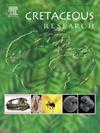A remarkable new genus of Symphrasinae (Neuroptera: Mantispidae) from mid-Cretaceous amber of Myanmar, and the problem of the phylogenetic affinities of Rhachiberothidae
IF 1.7
3区 地球科学
Q1 GEOLOGY
引用次数: 0
Abstract
Rhachisymphrasis raehlei gen. et sp. nov. (Neuroptera: Mantispidae: Symphrasinae) is described from mid-Cretaceous Kachin amber. The genus is remarkable for possessing many character states which do not occur in other Symphrasinae: the profemur is slender; the protibia is very short; the lanceolate process of the probasitarsus arises from its tip and is relatively thin; the mesotibia is strongly expanded; and the forewing CuP is shallowly forked. The protarsus of Rhachisymphrasis gen. nov. is rather similar to that of Rhachiberothidae. However, it is unclear whether Rhachiberothidae is phylogenetically closer to Mantispidae or Berothidae. The most plausible hypothesis is that Rhachiberothidae constitute an ancient branch of Mantispoidea leading to Mantispidae (including Symphrasinae), but retaining many character states of Berothidae. The symphrasine affinity of Sinomesomantispa Jepson et al., 2013 from the Lower Cretaceous of China is confirmed.
缅甸中白垩世琥珀合蛛科新属(神经翅目:螳螂科)及其系统发育亲缘关系问题
rachisymphrasis raehlei gen. et sp. 11 .(神经翅目:螳螂科:螳螂科)来自中白垩世克钦琥珀。该属的显著特点是具有许多在其他合孢科中所没有的特征状态:柱头纤细;时间很短;近跖骨的披针形突起起于其尖端,相对较薄;中胫肌强烈扩张;前杯呈浅分叉。石竹属的前跗关节与石竹科的前跗关节非常相似。然而,目前尚不清楚在系统发育上Rhachiberothidae是否更接近Mantispidae或Berothidae。最合理的假设是,尾蛛科构成了螳螂科的一个古老分支,导致了螳螂科(包括合蛛科),但保留了许多蛛科的特征状态。中国下白垩统Sinomesomantispa Jepson et al., 2013证实了共phrasine亲和力。
本文章由计算机程序翻译,如有差异,请以英文原文为准。
求助全文
约1分钟内获得全文
求助全文
来源期刊

Cretaceous Research
地学-地质学
CiteScore
4.10
自引率
19.00%
发文量
235
审稿时长
12 weeks
期刊介绍:
Cretaceous Research provides a forum for the rapid publication of research on all aspects of the Cretaceous Period, including its boundaries with the Jurassic and Palaeogene. Authoritative papers reporting detailed investigations of Cretaceous stratigraphy and palaeontology, studies of regional geology, and reviews of recently published books are complemented by short communications of significant new findings.
Papers submitted to Cretaceous Research should place the research in a broad context, with emphasis placed towards our better understanding of the Cretaceous, that are therefore of interest to the diverse, international readership of the journal. Full length papers that focus solely on a local theme or area will not be accepted for publication; authors of short communications are encouraged to discuss how their findings are of relevance to the Cretaceous on a broad scale.
Research Areas include:
• Regional geology
• Stratigraphy and palaeontology
• Palaeobiology
• Palaeobiogeography
• Palaeoceanography
• Palaeoclimatology
• Evolutionary Palaeoecology
• Geochronology
• Global events.
 求助内容:
求助内容: 应助结果提醒方式:
应助结果提醒方式:


